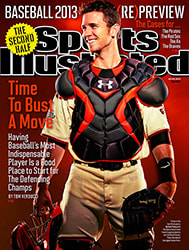
Strokes of Genius
The EDGE
Lynne Cox has an unusual combination of talents. She's an elite athlete—one of the most accomplished long-distance swimmers ever—and a superb DIY writer. Ted Williams, writing his classic The Science of Hitting, got help with the typing from SI's John Underwood. Ben Hogan had Herbert Warren Wind in the wings, and Andre Agassi had J.R. Moehringer. But Lynne Cox's books are the works of a singular mind. That was true for the best sellers Swimming to Antarctica and Grayson, and it is true for her new book, Open Water Swimming Manual, a 300-page paperback instructional that is the most unlikely page-turner you could put on your summer reading list.
She's written a sort of fantasy in which you, the reader, are the protagonist. You can't swim half a mile? Cox will put you on a program to swim 10!
Yes, she's flying her caution flag all the while. The specters of death and mayhem (jellyfish, Jet Skis) are in every chapter. She pushes the same safety note your parents sounded: Swim near a lifeguard, a word she defines broadly and loves.
But her big move is to try to change your mind-set. I told her I was amused by the ninth step of the workout she proposes on page 144: "Swim your ninth mile as a sprint." She said, "If my memory's right, I think that's Workout 2." You know, for intermediates.
The scale will most likely be different, but Cox's Open Water Swimming Manual could do for long-distance swimming what Jim Fixx's The Complete Book of Running did for the American jogging movement in 1977.
There's a big nod to the target audience in her subtitle: An expert's survival guide for triathletes and open water swimmers. In 2000, USA Triathlon had 122,388 members. As of last year, the number had grown to a record 550,466. Talk about your growth industries. Cox is tapping the source. (Yes, an intentional reference to Kem Nunn's Tapping the Source, the greatest surf novel ever, set in Huntington Beach, Calif., a.k.a. Surf City.)
Cox lives in Southern California, but I caught up with her recently in New York City, outside her literary agent's apartment building on the Upper West Side. We had iced coffee on a sidewalk bench. Cox is in her mid-50s and has electric eyes, bright-white teeth, bronzed skin and (often) wet hair. She's hard to quote. She has a nimble mind, and her sentences go on forever, until she trots out the phrase, "I'm babbling," much like Diane Keaton, in Annie Hall, used "la-di-da, la-di-da, la la" as final punctuation.
But if you wade through her torrent of words, you'll consistently find keepers. She said, "They said that when Sully"—US Airways pilot Chesley Sullenberger—"landed that plane in the Hudson, the passengers could only survive 20 minutes in that 38° water, and that's not true!" In the manual Cox revisits longer swims in colder waters. She wants you to reconsider yourself.
I gave her a lift to Kennedy Airport, and on the way there we made a pit stop at Rockaway Beach, on the Atlantic. Earlier, I had asked Cox if she prefers swimming in seawater, brackish water or fresh water. She said, "That's like asking a parent to pick a favorite child!" But I have the feeling Cox's first love is the ocean. Any one of the five will do.
On the boardwalk Cox had her shoes off in one quick flick, and soon after she had her tanned feet in the foamy gray water. There was no kelp, no swimmers, and apartment buildings were where dunes should be. But she was on a beach and she was happy. She said, "This is so beautiful!"
She asked the lifeguard at 77th Street, a mellow and knowledgeable college student named Ryan Meade, about stingrays and marked swimming distances. In his Queens accent, Meade said, "Twenty blocks make a mile. You can swim all you want."
Meade knew he was talking to a serious swimmer, and Cox knew the same. She nodded enthusiastically, like she would be coming back.
PHOTO
GABRIELLA MIOTTO
SUITED FOR SUCCESS Cox, whose epic swims include an Antarctic dip (top), aims to help the amateur reach new levels.
PHOTO
COURTESY OF VINTAGE BOOKS (BOOK)
[See caption above]

